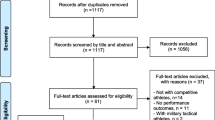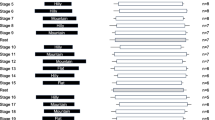Abstract
Purpose
Despite the reported detrimental effects of international air travel on physical performance, a paucity of interventions have been scientifically tested and confirmed to benefit travelling athletes. Consequently, the aim of the present study was to examine the effects of sleep hygiene and artificial bright light interventions on physical performance following simulated international travel.
Methods
In a randomized crossover design, 13 physically active males completed 24 h of simulated international travel with (INT) and without (CON) the interventions. The mild hypoxia and cramped conditions typically encountered during commercial air travel were simulated in a normobaric, hypoxic room. Physical performance, subjective jet-lag symptoms and mood states were assessed in the morning and evening on the day prior to and for two days post-travel. Sleep quantity and quality were monitored throughout each trial.
Results
Sleep duration was significantly reduced during travel in both trials (P < 0.01), though total sleep duration during and following travel was almost significantly greater (P = 0.06) in INT (17.0 (16.2–17.8) h) compared to CON (15.7 (14.9–16.5) h). Maximal-sprint and countermovement jump (P < 0.05), but not Yo–Yo Intermittent Recovery level 1 test (P > 0.05) performance, were significantly reduced the evening of day 1 and 2 post-travel, with no differences between trials (P > 0.05). Furthermore, vigour was significantly greater (P = 0.04) the morning of day 2 in INT [5.3 (3.9–6.7)] compared to CON [2.8 (1.4–4.2)], and subjective jet-lag symptoms and mood states were significantly worse on day 2 in CON only (P < 0.05).
Conclusions
Whilst reducing travel-induced sleep disruption may attenuate travel fatigue, no improvements in the recovery of physical performance were apparent.



Similar content being viewed by others
Abbreviations
- AEST:
-
Australian Eastern Standard Time
- CI:
-
Confidence intervals
- CMJ:
-
Countermovement jump
- CON:
-
Control trial
- GMT:
-
Greenwich Mean Time
- INT:
-
Intervention trial
- YYIR1:
-
Yo-Yo Intermittent Recovery level 1 test
References
Australian Institute of Sport (2000) Physiological Tests for Elite Athletes. Gore C and Tanner R (eds). Second ed. Human Kinetics, Champaign, IL
Bangsbo J, Iaia FM, Krustrup P (2008) The Yo-Yo Intermittent Recovery Test. A Useful Tool for Evaluation of Physical Performance in Intermittent Sports. Sports Med 38:37–51
Belenky G, Wesensten NJ, Thorne DR, Thomas ML, Sing HC, Redmond DP, Russo MB, Balkin TJ (2003) Patterns of performance degradation and restoration during sleep restriction and subsequent recovery: a sleep dose-response study. J Sleep Res 12:1–12
Buchheit M, Voss SC, Nybo L, Mohr M, Racinais S (2011) Physiological and performance adaptations to an in-season soccer camp in the heat: associations with heart rate and heart rate variability. Scand J Med Sci Sports 21:477–485
Bullock N, Martin DT, Ross A, Rosemond D, Marino FE (2007) Effect of long haul travel on maximal sprint performance and diurnal variations in elite skeleton athletes. Br J Sports Med 41:569–573
Chapman DW, Bullock N, Ross A, Rosemond D, Martin DT (2012) Detrimental effects of West to East transmeridian flight on jump performance. Eur J Appl Physiol 112:1663–1669
Coste O, Beaumont M, Batejat D, Van Beers P, Charbuy H, Touitou Y (2004) Hypoxic depression of melatonin secretion after simulated long duration flights in man. J Pineal Res 37:1–10
Coste O, Van Beers P, Touitou Y (2009) Hypoxia-induced changes in recovery sleep, core body temperature, urinary 6-sulphatoxymelatonin and free cortisol after a simulated long-duration flight. J Sleep Res 18:454–465
Czeisler CA, Kronauer RE, Allan JS, Duffy JF, Jewett ME, Brown EN, Ronda JM (1989) Bright light induction of strong (type 0) resetting of the human circadian pacemaker. Science 244:1328–1333
Drust B, Waterhouse J, Atkinson G, Edwards B, Reilly T (2005) Circadian rhythms in sports performance - an update. Chronobiol Int 22:21–44
Duffy JF, Dijk DJ, Klerman EB, Czeisler CA (1998) Later endogenous circadian temperature nadir relative to an earlier wake time in older people. Am J Physiol Regul Integr Comp Physiol 275:R1478–R1487
Forbes-Robertson S, Dudley E, Vadgama P, Cook C, Drawer S, Kilduff L (2012) Circadian disruption and remedial interventions: effects and interventions for jet lag for athletic peak performance. Sports Med 42:185–208
Foster C, Daines E, Hector L, Snyder AC, Welsh R (1996) Athletic performance in relation to training load. Wis Med J 95:370–374
Galambos SA, Terry PC, Moyle GM, Locke SA, Lane AM (2005) Psychological predictors of injury among elite athletes. Br J Sports Med 39:351–354
Geertsema C, Williams AB, Dzendrowskyj P, Hanna C (2008) Effect of commercial airline travel on oxygen saturation in athletes. Br J Sports Med 42:877–881
Gronfier C, Wright KP Jr, Kronauer RE, Jewett ME, Czeisler CA (2004) Efficacy of a single sequence of intermittent bright light pulses for delaying circadian phase in humans. Am J Physiol Endocrinol Metab 287:E174–E181
Halson SL (2013) Sleep and the elite athlete. Sports Science 26:1–4
Hardy CJ, Rejeski WJ (1989) Not what, but how one feels: the measurement of affect during exercise. J Sport Exerc Psychol 11:304–317
Krustrup P, Mohr M, Amstrup T, Rysgaard T, Johansen J, Steensberg A, Pedersen PK, Bangsbo J (2003) The yo-yo intermittent recovery test: physiological response, reliability, and validity. Med Sci Sports Exerc 35:697–705
Lagarde D, Chappuis B, Billaud PF, Ramont L, Chauffard F, French J (2001) Evaluation of pharmacological aids on physical performance after a transmeridian flight. Med Sci Sports Exerc 33:628–634
Leatherwood WE, Dragoo JL (2012) Effect of airline travel on performance: a review of the literature. Br J Sports Med 47:561–567
Maughan R (2003) Impact of mild dehydration on wellness and on exercise performance. Eur J Clin Nutr 57:S19–S23
Meerlo P, Sgoifo A, Suchecki D (2008) Restricted and disrupted sleep: effects on autonomic function, neuroendocrine stress systems and stress responsivity. Sleep Med Rev 12:197–210
Ozcan HK, Nemlioglu S (2006) In-cabin noise levels during commercial aircraft flights. Canadian Acoustics 34:31–35
Pierard C, Beaumont M, Enslen M, Chauffard F, Tan DX, Reiter RJ, Fontan A, French J, Coste O, Lagarde D (2001) Resynchronization of hormonal rhythms after an eastbound flight in humans: effects of slow-release caffeine and melatonin. Eur J Appl Physiol 85:144–150
Reilly T, Edwards B (2007) Altered sleep-wake cycles and physical performance in athletes. Physiol Behav 90:274–284
Reilly T, Atkinson G, Budgett R (2001) Effect of low-dose temazepam on physiological variables and performance tests following a westerly flight across five time zones. Int J Sports Med 22:166–174
Reilly T, Atkinson G, Edwards B, Waterhouse J, Åkerstedt T, Davenne D, Lemmer B, Wirz-Justice A (2007a) Coping with jet-lag: a position statement for the European College of Sport Science. Eur J Sport Sci 7:1–7
Reilly T, Waterhouse J, Burke LM, Alonso JM (2007b) Nutrition for travel. J Sports Sci 25:S125–S134
Sargent C, Darwent D, Ferguson SA, Kennaway DJ, Roach GD (2012) Sleep restriction masks the influence of the circadian process on sleep propensity. Chronobiol Int 29:565–571
Sargent C, Halson S, Roach GD (2014) Sleep or swim? Early-morning training severely restricts the amount of sleep obtained by elite swimmers. Eur J Sport Sci 14:S310–S315
Savourey G, Launay JC, Besnard Y, Guinet A, Travers S (2003) Normo- and hypobaric hypoxia: are there any physiological differences? Eur J Appl Physiol 89:122–126
Simons R, Krol J (1996) Jet leg, pulmonary embolism, and hypoxia. The Lancet 348:416
Skein M, Duffield R, Edge J, Short MJ, Mundel T (2011) Intermittent-sprint performance and muscle glycogen after 30 h of sleep deprivation. Med Sci Sports Exerc 43:1301–1311
Takahashi M, Nakata A, Arito H (2002) Disturbed sleep–wake patterns during and after short-term international travel among academics attending conferences. Int Arch Occup Environ Health 75:435–440
Taylor KL, Cronin J, Gill ND, Chapman DW, Sheppard J (2010) Sources of variability in iso-inertial jump assessments. Int J Sports Physiol Perform 5:546–558
Thompson A, Batterham A, Jones H, Gregson W, Scott D, Atkinson G (2013) The Practicality and Effectiveness of Supplementary Bright Light for Reducing Jet-Lag in Elite Female Athletes. Int J Sports Med 34:582–589
Waterhouse J, Edwards B, Nevill A, Atkinson G, Reilly T, Davies P, Godfrey R (2000) Do subjective symptoms predict our perception of jet-lag? Ergonomics 43:1514–1527
Waterhouse J, Reilly T, Atkinson G, Edwards B (2007) Jet lag: trends and coping strategies. The Lancet 369:1117–1129
Wood B, Rea MS, Plitnick B, Figueiro MG (2013) Light level and duration of exposure determine the impact of self-luminous tablets on melatonin suppression. Appl Ergon 44:237–240
Wright K, Badia P, Myers B, Plenzer S (1997) Combination of bright light and caffeine as a countermeasure for impaired alertness and performance during extended sleep deprivation. J Sleep Res 6:26–35
Wright HR, Lack LC, Kennaway DJ (2004) Differential effects of light wavelength in phase advancing the melatonin rhythm. J Pineal Res 36:140–144
Wyatt JK, Cecco AR-D, Czeisler CA, Dijk D-J (1999) Circadian temperature and melatonin rhythms, sleep, and neurobehavioral function in humans living on a 20-h day. Am J Physiol Regul Integr Comp Physiol 277:R1152–R1163
Acknowledgments
The authors would like to thank the participants for their time and enthusiasm and gratefully acknowledge the allocation of resources provided by the School of Human Movement Studies, Charles Sturt University (Bathurst, Australia) and the Physiology Department, Australian Institute of Sport (Canberra, Australia) in support of this project. The authors would also like to thank Dr Emma Knight for her assistance with statistical analyses.
Conflict of interest
The authors report no conflicts of interest.
Author information
Authors and Affiliations
Corresponding author
Additional information
Communicated by Dick F. Stegeman.
Rights and permissions
About this article
Cite this article
Fowler, P.M., Duffield, R., Morrow, I. et al. Effects of sleep hygiene and artificial bright light interventions on recovery from simulated international air travel. Eur J Appl Physiol 115, 541–553 (2015). https://doi.org/10.1007/s00421-014-3043-2
Received:
Accepted:
Published:
Issue Date:
DOI: https://doi.org/10.1007/s00421-014-3043-2




